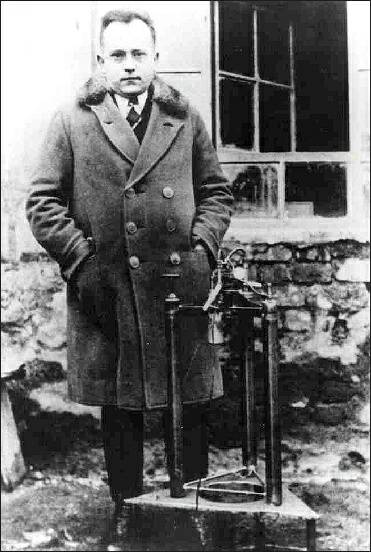 |
 Rocket schema - Credit: Peter Alway |
Biographie:
Built the first liquid propellant rocket in Europe.- Johannes Winkler was born on May 29, 1897, in Karlsruhe, Germany. He attended primary school in Karlsruhe, and middle school in Oppeln. After graduating high school in Liegnitz in 1915, Winkler enlisted in the army. Seriously wounded in 1916, during the Battle of Lake Narocz, he spent seven months recuperating in the hospital. Upon release, he was excused from further military service and decided to study machine construction at the Technische Hoshschule in Danzig (now Gdansk, Poland), graduating in May 1918.
- In the 1920's, Winkler developed a love for astronomy, aviation, and rocketry while working as an engineer at the Junkers Aircraft Company.
- On June 5, 1927, a small group of men gathered in Breslau to founded the German Rocket Society (VfR - Verein fur Raumschiffahrt) in Breslau, Germany (now Wroclaw, Poland). Within a year the VfR would boast a membership of 500, including most of the early twentieth century's European rocket pioneers. From 1927 to December 1929, Winkler edited and published the club's magazine, Die Rakete (The Rocket), the world's first journal of rocketry while also serving as the VfR's first president.
- In 1929, the aircraft manufacturer Junkers hired Winkler to study solid propellant rockets for use in the jet-assisted takeoff of aircraft. In 1930, he left Junkers for a period to develop a liquid propellant rocket financed by the wealthy manufacturer and rocket enthusiast Hugo Hückel. By 1931, using rocket pioneer Hermann Oberth's calculations, Winkler designed, built, and flew the first liquid propellant rocket in Europe, five years after Robert Goddard of the United States had launched the world's earliest liquid-fuelled rocket.
- Winkler's rocket, the Hückel-Winkler I (HW-I), was two feet high and weighed eleven pounds at takeoff. It was propelled by high-pressure nitrogen gas forcing liquid methane and liquid oxygen into a combustion chamber. A central combustion chamber was surround by three cylindrical tanks, two containing liquid oxygen and the third liquid methane. Launched in Dessau, Germany on February 21, 1931, the HW-1 failed after flying only ten feet.
- on March 14, 1931, Winkler launched another HW-1. According to his account, it was planned to reach an altitude of 500 meters, but it turned and flew horizontally, landing 200 meters from the pad. The maximum altitude of the rocket was not recorded. It was powered by liquid oxygen and liquid methane. Most of the world thought this was the first liquid fueled ′rocket to fly until Goddard revealed his 1926 flight in 1936. Winkler also tested a lengthened version, the HW-IA.
- On October 6, 1932, after months of work, Winkler launched a more advanced rocket, the HW-2, on the Baltic Sea coast
near Pillau, Germany. The HW-II was designed for maximum efficiency.
Seventy-two percent of the rockets mass was propellant, a record for the time (including Goddard′s rockets), and a teardrop-shaped shell minimized aerodynamic drag. The latest technology was used throughout, including a new aluminum-magnesium alloy, "electron" used in the propellant valves. This would prove to be the downfall of the HW-II, as nobody was yet aware that salt air corroded the new material. The six-foot high rocket had been exposed to corrosive sea air for weeks during launch delays and some of its alloys had deteriorated. An internal breakdown led to an explosive propellant mix in the rocket, and after rising only ten feet, it exploded. With the failure of the HW-2, Winkler gave up rocketry as a profession and returned to his old job at Junkers. He continued to experiment with rockets on his own for a year, until Adolf Hitler's Nazi government outlawed all private rocket research in Germany. Johannes Winkler worked for the German military's Aeronautical Research Institute during World War II, designing Jet Assisted Take-off (JATO) units and sounding rockets but none of them were ever put into production. - His health ruined by the war, Johannes Winkler died in a refugee camp at Braunschweig-Querum, Germany on December 27, 1947.